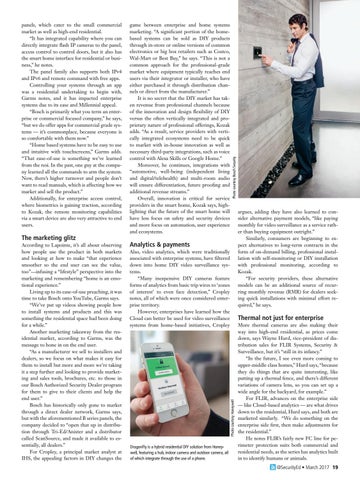The marketing glitz According to Lapointe, it’s all about observing how people use the product in both markets and looking at how to make “that experience smoother so the end user can see the value, too”—infusing a “lifestyle” perspective into the marketing and remembering “home is an emotional experience.” Living up to its ease-of-use preaching, it was time to take Bosch onto YouTube, Garms says. “We’ve put up videos showing people how to install systems and products and this was something the residential space had been doing for a while.” Another marketing takeaway from the residential market, according to Garms, was the message to hone in on the end user. “As a manufacturer we sell to installers and dealers, so we focus on what makes it easy for them to install but more and more we’re taking it a step further and looking to provide marketing and sales tools, brochures, etc. to those in our Bosch Authorized Security Dealer program for them to give to their clients and help the end user.” Bosch has historically only gone to market through a direct dealer network, Garms says, but with the aforementioned B series panels, the company decided to “open that up in distribution through Tri-Ed/Anixter and a distributor called ScanSource, and made it available to essentially, all dealers.” For Cropley, a principal market analyst at IHS, the appealing factors in DIY changes the
Photo courtesy Bosch Security
game between enterprise and home systems marketing. “A significant portion of the homebased systems can be sold as DIY products through in-store or online versions of common electronics or big box retailers such as Costco, Wal-Mart or Best Buy,” he says. “This is not a common approach for the professional-grade market where equipment typically reaches end users via their integrator or installer, who have either purchased it through distribution channels or direct from the manufacturer.” It is no secret that the DIY market has taken revenue from professional channels because of the innovation and design flexibility of DIY versus the often vertically integrated and proprietary nature of professional offerings, Kozak adds. “As a result, service providers with vertically integrated ecosystems need to be quick to market with in-house innovation as well as necessary third-party integrations, such as voice control with Alexa Skills or Google Home.” Moreover, he continues, integrations with “automotive, well-being (independent living and digital/telehealth) and multi-room audio will ensure differentiation, future proofing and additional revenue streams.” Overall, innovation is critical for service providers in the smart home, Kozak says, highlighting that the future of the smart home will have less focus on safety and security devices and more focus on automation, user experience and ecosystems.
argues, adding they have also learned to consider alternative payment models, “like paying monthly for video surveillance as a service rather than buying equipment outright.” Similarly, consumers are beginning to expect alternatives to long-term contracts in the form of on-demand billing, professional installation with self-monitoring or DIY installation with professional monitoring, according to Kozak. “For security providers, these alternative models can be an additional source of recurring monthly revenue (RMR) for dealers seeking quick installations with minimal effort required,” he says.
Analytics & payments Also, video analytics, which were traditionally associated with enterprise systems, have filtered down into home DIY video surveillance systems. “Many inexpensive DIY cameras feature forms of analytics from basic trip wires to ‘zones of interest’ to even face detection,” Cropley notes, all of which were once considered enterprise territory. However, enterprises have learned how the Cloud can better be used for video surveillance systems from home-based initiatives, Cropley
Thermal not just for enterprise
Photo courtesy Honeywell
panels, which cater to the small commercial market as well as high-end residential. “It has integrated capability where you can directly integrate flash IP cameras to the panel, access control to control doors, but it also has the smart home interface for residential or business,” he notes. The panel family also supports both IPv4 and IPv6 and remote command with free apps. Controlling your systems through an app was a residential undertaking to begin with, Garms notes, and it has impacted enterprise systems due to its ease and Millennial appeal. “Bosch is primarily what you term an enterprise or commercial focused company,” he says, “but we do offer apps for commercial grade systems — it’s commonplace, because everyone is so comfortable with them now.” “Home based systems have to be easy to use and intuitive with touchscreens,” Garms adds. “That ease-of-use is something we’ve learned from the resi. In the past, one guy at the company learned all the commands to arm the system. Now, there’s higher turnover and people don’t want to read manuals, which is affecting how we market and sell the product.” Additionally, for enterprise access control, where biometrics is gaining traction, according to Kozak, the remote monitoring capabilities via a smart device are also very attractive to end users.
DragonFly is a hybrid residential DIY solution from Honeywell, featuring a hub, indoor camera and outdoor camera, all of which integrate through the use of a phone.
More thermal cameras are also making their way into high-end residential, as prices come down, says Wayne Hurd, vice-president of distribution sales for FLIR Systems, Security & Surveillance, but it’s “still in its infancy.” “In the future, I see even more coming to upper-middle class homes,” Hurd says, “because they do things that are quite interesting, like putting up a thermal fence, and there’s different variations of camera lens, so you can set up a wide angle for the backyard, for example.” For FLIR, advances on the enterprise side — like Cloud-based analytics — are what drives down to the residential, Hurd says, and both are marketed similarly. “We do something on the enterprise side first, then make adjustments for the residential.” He notes FLIR’s fairly new FC line for perimeter protection suits both commercial and residential needs, as the series has analytics built in to identify humans or animals.
@SecurityEd • March 2017 19
